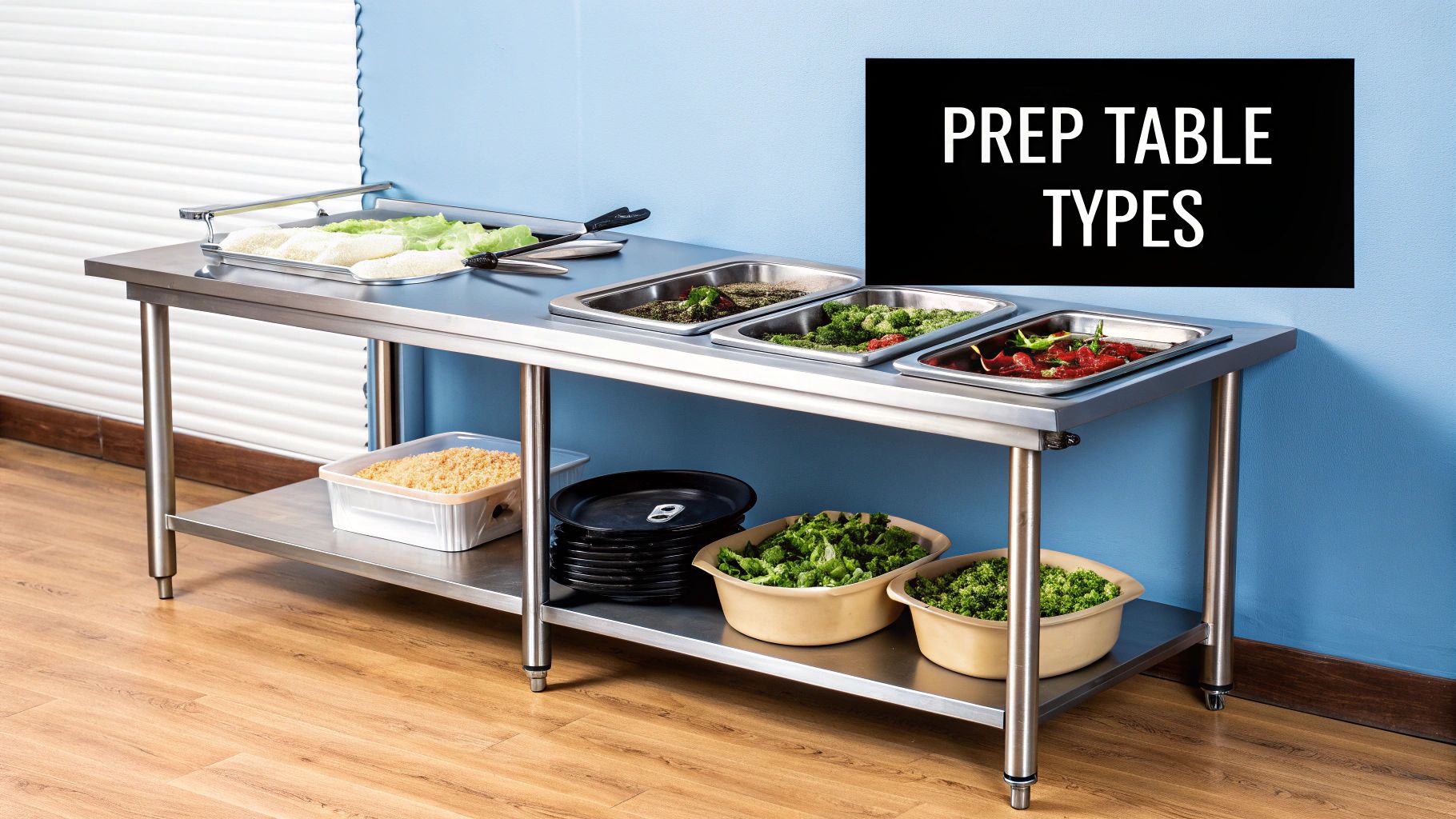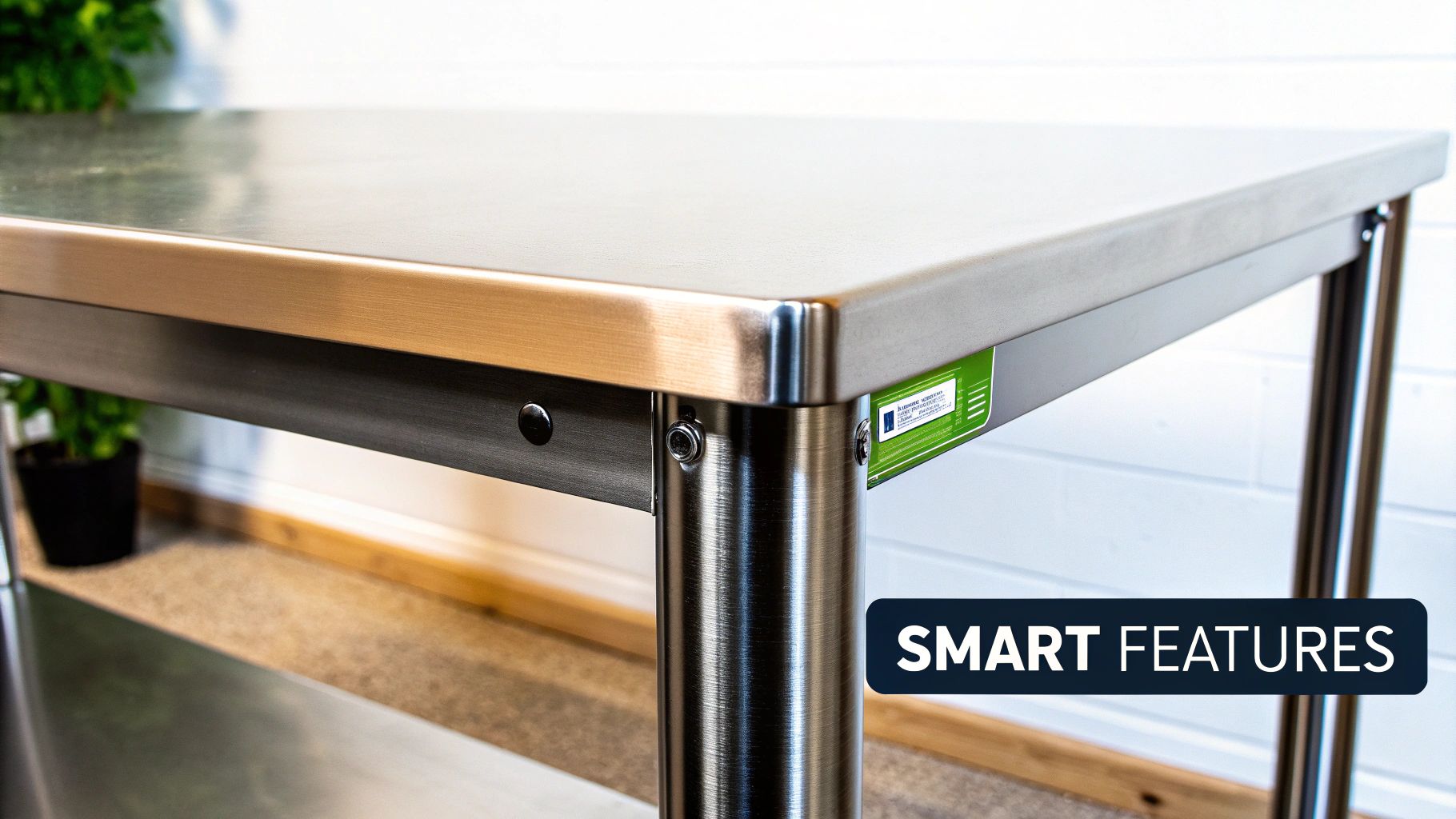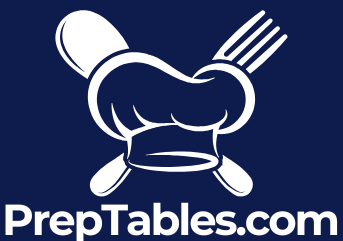
Your Guide to a Work Table Stainless Steel
Share
A high-quality stainless steel work table is the unsung hero of just about any professional setting, from a slammed restaurant kitchen to a meticulously clean medical lab. It’s so much more than just a surface to put things on; think of it as a fundamental tool built for unmatched hygiene, durability, and efficiency. A good table gives you a non-porous, corrosion-resistant workspace that makes upholding strict health and safety standards a whole lot easier.
Why Stainless Steel Is the Go-To Professional Standard
Picture a stainless steel work table as the operating room of a professional kitchen. It’s a completely neutral, sterile field where the most important work can happen cleanly and safely. This is all thanks to stainless steel being non-porous—a fancy way of saying there are no tiny cracks or holes for bacteria, food bits, and other contaminants to hide in.
Unlike a wood surface that can soak up moisture and become a breeding ground for germs, or a laminate top that can chip and expose its particleboard core, stainless steel forms an impenetrable barrier.
This built-in hygienic quality is precisely why it’s the gold standard in both food service and healthcare. You can sanitize the entire surface with minimal effort, which dramatically cuts down the risk of cross-contamination. For anyone working in these fields, meeting Modern Food Service Hygiene Standards is non-negotiable, and having stainless steel surfaces is a huge part of staying compliant.
Built for the Grind
Beyond just being clean, the sheer durability of stainless steel is a massive selling point for professionals. These tables are engineered to take a beating in a fast-paced commercial environment. They can handle heavy equipment being dropped on them, resist the heat from a scorching hot pan set down in a hurry, and won't corrode when splashed with acidic foods or harsh cleaning chemicals. This kind of resilience means you’re buying a piece of equipment for the long haul, not something you’ll have to replace every couple of years.
A stainless steel table isn't just another piece of furniture; it's a long-term investment in safety, efficiency, and the integrity of your work. Its ability to perform under pressure while staying impeccably clean makes it a non-negotiable asset.
A Market That’s All About Quality
The demand for these workhorse surfaces isn't just anecdotal—the market is growing fast. The global market for stainless steel work tables, currently valued at around $1.2 billion, is on track to hit $1.8 billion. This surge is all about the growing need for durable, easy-to-clean surfaces in professional kitchens, labs, and manufacturing facilities where sanitary conditions are absolutely critical.
If you want to dig deeper into the market's trajectory, you can check out the full report on stainless steel tables. This trend really just confirms a simple truth: when performance and safety are on the line, the pros turn to stainless steel.
Finding the Right Type of Work Table Stainless Steel
Not every stainless steel work table is built the same—and that's a good thing. Different jobs call for different designs. Once you move beyond the idea of a simple flat-top surface, you’ll discover a whole family of specialized tables, each one engineered to make a specific workflow smoother. They transform from mere furniture into an indispensable tool for efficiency.
Standard Work Tables with Smart Features
Even the most "basic" work table stainless steel models offer a range of features designed for specific needs. The choice between a flat top and one with a backsplash is a primary example. A flat top is ideal for island configurations where staff work from all sides. A backsplash, on the other hand, is essential for tables placed against a wall, preventing food debris and liquids from sliding into hard-to-clean gaps.
Another key feature is the undershelf. It can be a solid surface for storing bulk ingredients or a slatted one that allows for better air circulation and is easier to clean. Some tables even offer adjustable undershelves, giving you the flexibility to store items of varying heights, from small containers to larger equipment. These seemingly minor details are what adapt a simple table to the unique rhythm of your workspace.
Sandwich and Salad Prep Tables
Imagine a bustling deli during the lunch rush. A sandwich prep table is the command center of this operation. These units are brilliantly designed, combining a refrigerated base for bulk storage with a flat work surface and a row of chilled wells (often called "bains") right on top.

This setup keeps all your essential ingredients—lettuce, tomatoes, sliced meats, cheeses—cool, food-safe, and literally at your fingertips.
This design completely eliminates the need to constantly walk back and forth to a separate refrigerator, which dramatically slashes assembly time. It’s a smart, ergonomic solution that not only makes the kitchen more efficient but also ensures food safety and keeps the customer line moving swiftly.
Salad prep tables work on the exact same principle, providing a streamlined station to build fresh salads with every ingredient perfectly chilled and organized in one place. If you're looking to explore more about these efficient units, you can learn more about commercial refrigerated prep tables in our detailed guide.
Specialized tables are not just about convenient storage; they are about motion economy. By placing everything a chef needs within arm's reach, they reduce wasted steps and transform a potentially chaotic process into a smooth, efficient workflow.
Pizza Prep Tables
Now, let's head over to a busy pizzeria on a Friday night. A pizza prep table is an entirely different beast, built from the ground up to handle the unique challenges of making pies. First and foremost, they usually have an extra-deep work surface. This gives you plenty of room to stretch dough without sending flour flying everywhere. This larger workspace is critical for a process that requires more elbow room than making a sandwich.

The real magic, however, lies in the raised, refrigerated rail that runs along the back of the work surface. This is where you keep all your topping pans—pepperoni, mushrooms, onions, bell peppers, and cheese—perfectly organized and chilled.
Below the workspace, a refrigerated cabinet holds your bulk items like proofed dough boxes, extra sauce, and more cheese, ensuring you are always stocked and ready for the next order.
Much like its sandwich-making counterpart, the pizza prep table is a masterclass in workflow optimization. It brings every single step of making a pizza, from dough to toppings, into one self-contained station. This logical layout is the secret to churning out pizzas quickly and consistently, especially during peak hours. From stretching the dough to sliding the finished pie into the oven, the entire process happens in one seamless, efficient flow.
Essential Features for Smart Buyers
Once you've picked the right general type of stainless steel work table, it's time to zoom in on the details. These are the small, yet critical, features that separate a workhorse table from one that will give you headaches down the road. Think of this as your buyer's checklist—the stuff that really defines quality and day-to-day usability.

We'll start with the very edges of the table. It might seem like a minor detail, but the edge type has a surprisingly big impact on both safety and workflow, especially in a fast-paced kitchen where staff are constantly on the move.
Choosing the Right Edge Type
The two most common edge styles you'll run into are squared and bullnose. A squared edge is a clean, sharp, 90-degree corner. This style is perfect if you need to place tables flush against each other to create one long, seamless workspace without any gaps.
Then there's the bullnose edge, which is rounded and smooth. In high-traffic areas, this is a huge safety plus. The rounded design helps prevent painful bumps, bruises, and snagged aprons as people hurry past. If your table is going to be a central island or sit in a main walkway, the bullnose edge is almost always the smarter, safer pick.
The Importance of Stability and Ergonomics
Here's a feature that's easy to overlook but can make or break your daily experience: the legs. Let's be honest, commercial kitchen floors are rarely perfectly level. An uneven floor can turn your prep surface into a wobbly, unstable, and dangerous mess. This is where adjustable legs come to the rescue.
Most quality commercial tables are equipped with adjustable bullet feet. These let you tweak the height of each leg individually until your work table stainless steel surface is perfectly level and solid, no matter how slanted the floor is. It's also a great way to make minor height adjustments for better ergonomics, which can save your staff a lot of back pain during a long shift.
A table is only as good as its foundation. Adjustable legs provide the stability needed for safe and precise work, turning a potentially wobbly surface into a rock-solid workstation.
NSF Certification: The Mark of Safety
For any table that will be used in a commercial kitchen or food prep area, one thing is absolutely non-negotiable: NSF certification. The National Sanitation Foundation (NSF) is an independent body that tests products to make sure they meet strict public health and safety standards.
When a table is NSF-certified, it's been put through its paces to confirm that:
- It’s built from food-safe materials.
- The surface is smooth, non-porous, and a breeze to clean.
- The design has no cracks or crevices where bacteria can hide and multiply.
Seeing that NSF seal is your guarantee that the table is safe for food to touch directly and will fly through health inspections. It’s a vital mark of quality you should never skip.
Practical Add-Ons for a Better Workflow
Beyond the core construction, think about the practical add-ons that can turn a simple surface into a full-blown workstation. These accessories are all about improving organization and efficiency, letting you customize the table for how you actually work.
Some of the most useful add-ons include:
- Drawers for stashing utensils, thermometers, and other small tools to keep your main workspace clear.
- Integrated sinks that are perfect for creating a dedicated wash or prep station, cutting down on trips across the kitchen.
- Casters (wheels) which can transform a stationary table into a mobile one. This gives you the flexibility to reconfigure your space on the fly. Just make sure you get locking casters so the table stays put when you're working.
Each of these features adds real value. By carefully thinking through these details—from the edges and legs to certifications and accessories—you can choose a work table stainless steel that isn’t just another piece of equipment, but a smart investment in your kitchen's efficiency.
Care and Maintenance for a Lifetime of Service
Think of your stainless steel work table as a serious investment in your kitchen's future. It’s built to last, but just like a high-performance car, a little bit of regular care is all it takes to keep it in prime condition for decades.
The real magic of stainless steel is an invisible, paper-thin layer of chromium oxide that forms on the surface. This "passive film" is what protects the steel from rust and corrosion. Anything that scratches this layer or covers it up—like caked-on food, grime, or harsh chemicals—opens the door to damage. So, cleaning isn't just about appearances; it's about maintaining that protective shield.
Daily Cleaning for Lasting Shine
The best way to keep your table looking new is to stay ahead of the mess. A quick wipe-down at the end of the day prevents food and grease from hardening into a much bigger problem later. It's a small habit that pays off big time.
You don’t need anything fancy for daily cleaning.
- Keep it simple: A soft cloth or sponge with a bit of mild detergent and warm water is perfect for most jobs.
- Go with the grain: Look closely at the surface and you'll see tiny lines from the finishing process. Wiping parallel to this "grain" helps avoid tiny scratches and keeps the finish looking sharp.
- Rinse it clean: After washing, always give it a good rinse with plain water. This gets rid of any soap residue that can leave behind streaks or a dull film.
- Dry it off: To prevent water spots, especially if you have hard water, give the table a final wipe with a dry, soft cloth. It only takes a second and brings back that brilliant shine.
For a more detailed breakdown, our guide on how to clean stainless steel has plenty of extra tips.
Handling Tough Stains and Avoiding Damage
Of course, sometimes you’ll face tougher messes like baked-on grease or stubborn food stains. For these situations, a simple paste made from baking soda and water works wonders. It's gentle enough not to scratch the surface. Just apply the paste, scrub lightly with a soft brush (again, with the grain), then rinse and dry.
Knowing what not to do is just as important as knowing what to do. A few common cleaning products can cause permanent damage.
Critical Maintenance Don'ts:
- Never use steel wool or abrasive pads. These will absolutely scratch the finish, destroying that protective chromium layer and practically inviting rust to form.
- Avoid chlorine-based cleaners and bleach. Chlorine is public enemy number one for stainless steel. It causes pitting and corrosion that can’t be reversed.
- Stay away from abrasive cleaning powders. These act like fine sandpaper, dulling the finish and creating micro-scratches that trap dirt.
This combination of durability and easy care is why stainless steel is the go-to material for professionals everywhere. In fact, the market for stainless steel household goods, including work tables, is valued at roughly $27 billion. This huge number just goes to show how much people trust this material. If you follow these simple steps, you're not just cleaning a table—you're protecting your investment and making sure it remains a clean, reliable workhorse for years to come.
Got Questions About Stainless Steel Tables? We've Got Answers
Stepping into the world of stainless steel tables can bring up a few questions. It's totally normal. Getting clear answers is the key to picking a table that doesn't just fit your kitchen, but fits how you work. Let's tackle some of the most common things people ask.
Which Stainless Steel Grade Is Best for Food Prep?
For anything involving food—especially moisture, salt, or acidic ingredients like citrus or tomatoes—304-grade stainless steel is the professional standard, no contest. The secret is its higher nickel content, which gives it top-notch protection against rust and corrosion. It's simply the safest and most durable choice when food is involved.
You might see the more budget-friendly 430-grade, and it’s perfectly fine for dry storage or holding equipment. But if the surface will see any kind of wet work, investing in 304-grade is the only way to guarantee hygiene and a long lifespan.
How Can I Tell If a Table Is High-Quality?
You don't have to be a metallurgist to spot a good table. Just look for three things: the steel gauge, any official certifications, and the way it’s put together.
- Steel Gauge: This is a classic "less is more" situation. A lower gauge number means thicker, stronger steel. For heavy-duty daily use, 14 or 16 gauge is what you want. For lighter tasks, 18 gauge will do the trick.
- NSF Certification: If it's for a commercial kitchen, this is non-negotiable. Look for the NSF (National Sanitation Foundation) seal. This little mark is your guarantee that the table meets strict public health and safety standards.
- Construction Quality: Check the little details. The welds should be smooth and polished, not rough. Give the legs a good shake—they should feel solid and be securely attached to the top.
Can I Put Hot Pans Right on the Surface?
Yep, you sure can. One of the best things about stainless steel is its incredible heat resistance. You can slide a hot pan right off the stove and onto the table without a second thought.
That said, while it's tough, it's not invincible. Repeatedly slamming an extremely hot pot onto the exact same spot on a thinner gauge table could eventually cause a tiny bit of warping over many years. It’s not something you need to worry about day-to-day, but using a trivet for searing-hot cast iron is a good habit to keep your surface perfectly flat for a lifetime.
A common misconception is that stainless steel is indestructible. While incredibly tough, consistent extreme heat on a localized spot can test its limits. Think of it as resilient, not invincible.
Are These Tables a Pain to Assemble?
Not at all. Most commercial stainless steel tables are designed to be put together quickly and easily. They typically show up flat-packed with everything you need, including an Allen wrench and simple instructions.
Usually, you just have to attach the legs and then slide the undershelf into place and tighten a few screws. One person can easily have the whole thing built in under 30 minutes. You’ll go from box to fully operational workstation with minimal fuss.
At PrepTables.com, we stock a huge variety of NSF-certified stainless steel tables built for the real world of professional kitchens. If you're ready to find the perfect foundation for your workspace, check out our collection.
